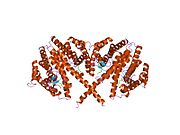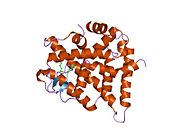Biology:Hepatocyte nuclear factor 4 alpha
 Generic protein structure example |
Hepatocyte nuclear factor 4 alpha (HNF4A) also known as NR2A1 (nuclear receptor subfamily 2, group A, member 1) is a nuclear receptor that in humans is encoded by the HNF4A gene.[1][2]
Function
HNF-4α is a nuclear transcription factor that binds DNA as a homodimer. The encoded protein controls the expression of several genes, including hepatocyte nuclear factor 1 alpha, a transcription factor which regulates the expression of several hepatic genes. This gene plays a role in development of the liver, kidney, and intestines. Alternative splicing of this gene results in multiple transcript variants.[3]
HNF4A is required for the PXR and CAR-mediated transcriptional activation of CYP3A4.[4] Genetic mutations in the HNF4A gene can influence the activity of HNF4α's downstream proteins such as CYP2D6, in vitro and in vivo.[5][6]
The alkaloid berberine upregulates the expression of HNF4A.[7]
This gene also plays a pivotal role in the expression and synthesis of SHBG, an important glycoprotein made primarily in the liver,[8] which in addition to lowering insulin-resistance also serves in reducing levels of free Estrogen as-well as prolonging the half-life of Testosterone.[citation needed]
Function of HNF4A gene can be effectively examined by siRNA knockdown based on an independent validation.[9]
Clinical significance
Mutations in the HNF4A gene are associated with a form of diabetes called maturity onset diabetes of the young (MODY),[10] specifically MODY 1. At least 56 disease-causing mutations in this gene have been discovered.[11]
Increased amplification of hepatocyte nuclear factor 4 alpha has been observed in colorectal cancer.[12]
It has also associations with the appearance of Fanconi syndrome phenotypes which occurs due to a missense mutation of the gene.[13]
Interactions
Hepatocyte nuclear factor 4 alpha has been shown to interact with:
- Beta-catenin,[14]
- CREB binding protein,[15][16]
- MED1,[17][18]
- MED14,[17][18]
- Small heterodimer partner[19]
- Testicular receptor 4,[20]
See also
References
- ↑ "Cloning and sequencing of cDNAs encoding the human hepatocyte nuclear factor 4 indicate the presence of two isoforms in human liver". Gene 147 (2): 269–72. Sep 1994. doi:10.1016/0378-1119(94)90079-5. PMID 7926813.
- ↑ "Human hepatocyte nuclear factor-4 (hHNF-4) gene maps to 20q12-q13.1 between PLCG1 and D20S17". Human Genetics 99 (2): 233–6. Feb 1997. doi:10.1007/s004390050345. PMID 9048927.
- ↑ "Entrez Gene: HNF4A hepatocyte nuclear factor 4, alpha". https://www.ncbi.nlm.nih.gov/sites/entrez?Db=gene&Cmd=ShowDetailView&TermToSearch=3172.
- ↑ "The orphan nuclear receptor HNF4alpha determines PXR- and CAR-mediated xenobiotic induction of CYP3A4". Nature Medicine 9 (2): 220–4. Feb 2003. doi:10.1038/nm815. PMID 12514743.
- ↑ "Genetic polymorphism of hepatocyte nuclear factor-4alpha influences human cytochrome P450 2D6 activity". Hepatology 48 (2): 635–45. 2008. doi:10.1002/hep.22396. PMID 18666237.
- ↑ "Effect of HNF4α genetic polymorphism G60D on the pharmacokinetics of CYP2D6 substrate tolterodine in healthy Korean individuals". Pharmacogenetics and Genomics 23 (3): 175–9. 2013. doi:10.1097/FPC.0b013e32835de25e. PMID 23292115.
- ↑ "Facilitating effects of berberine on rat pancreatic islets through modulating hepatic nuclear factor 4 alpha expression and glucokinase activity". World Journal of Gastroenterology 14 (39): 6004–11. Oct 2008. doi:10.3748/wjg.14.6004. PMID 18932278.
- ↑ Hammond, Geoffrey L.; Bocchinfuso, Wayne P. (2008-12-09). "Sex Hormone-Binding Globulin: Gene Organization and Structure/Function Analyses". Hormone Research 45 (3–5): 197–201. doi:10.1159/000184787. ISSN 0301-0163. PMID 8964583. https://doi.org/10.1159/000184787.
- ↑ Munkácsy, Gyöngyi; Sztupinszki, Zsófia; Herman, Péter; Bán, Bence; Pénzváltó, Zsófia; Szarvas, Nóra; Győrffy, Balázs (2016-01-01). "Validation of RNAi Silencing Efficiency Using Gene Array Data shows 18.5% Failure Rate across 429 Independent Experiments" (in en). Molecular Therapy: Nucleic Acids 5 (9): e366. doi:10.1038/mtna.2016.66. ISSN 2162-2531. PMID 27673562.
- ↑ "Roles of HNF1α and HNF4α in pancreatic β-cells: lessons from a monogenic form of diabetes (MODY)". Vitamins and Hormones 95: 407–23. 2014. doi:10.1016/B978-0-12-800174-5.00016-8. PMID 24559927.
- ↑ "Refinement of evolutionary medicine predictions based on clinical evidence for the manifestations of Mendelian diseases". Scientific Reports 9 (1): 18577. December 2019. doi:10.1038/s41598-019-54976-4. PMID 31819097. Bibcode: 2019NatSR...918577S.
- ↑ "Proteogenomic characterization of human colon and rectal cancer". Nature 513 (7518): 382–7. 2014. doi:10.1038/nature13438. PMID 25043054. Bibcode: 2014Natur.513..382..
- ↑ "Proximal renal tubular acidosis with and without Fanconi syndrome". Kidney Research and Clinical Practice 38 (3): 267–281. September 2019. doi:10.23876/j.krcp.19.056. PMID 31474092.
- ↑ "Functional localization and competition between the androgen receptor and T-cell factor for nuclear beta-catenin: a means for inhibition of the Tcf signaling axis". Oncogene 22 (36): 5602–13. Aug 2003. doi:10.1038/sj.onc.1206802. PMID 12944908.
- ↑ "Functional association between CBP and HNF4 in trans-activation". Biochemical and Biophysical Research Communications 241 (3): 664–9. Dec 1997. doi:10.1006/bbrc.1997.7871. PMID 9434765.
- ↑ "CREB-binding protein is a transcriptional coactivator for hepatocyte nuclear factor-4 and enhances apolipoprotein gene expression". The Journal of Biological Chemistry 274 (13): 9013–21. Mar 1999. doi:10.1074/jbc.274.13.9013. PMID 10085149.
- ↑ 17.0 17.1 "Polyamines modulate the interaction between nuclear receptors and vitamin D receptor-interacting protein 205". Molecular Endocrinology 16 (7): 1502–10. Jul 2002. doi:10.1210/mend.16.7.0883. PMID 12089346.
- ↑ 18.0 18.1 "TRAP/SMCC/mediator-dependent transcriptional activation from DNA and chromatin templates by orphan nuclear receptor hepatocyte nuclear factor 4". Molecular and Cellular Biology 22 (15): 5626–37. Aug 2002. doi:10.1128/MCB.22.15.5626-5637.2002. PMID 12101254.
- ↑ "The orphan nuclear receptor SHP inhibits hepatocyte nuclear factor 4 and retinoid X receptor transactivation: two mechanisms for repression". Molecular and Cellular Biology 20 (1): 187–95. Jan 2000. doi:10.1128/MCB.20.1.187-195.2000. PMID 10594021.
- ↑ "Suppression of hepatitis B virus core promoter by the nuclear orphan receptor TR4". The Journal of Biological Chemistry 278 (11): 9353–60. Mar 2003. doi:10.1074/jbc.M205944200. PMID 12522137.
Further reading
- "Monogenic diabetes mellitus in youth. The MODY syndromes". Endocrinology and Metabolism Clinics of North America 28 (4): 765–85. Dec 1999. doi:10.1016/S0889-8529(05)70101-8. PMID 10609119.
- "Transcriptional regulation of the human apolipoprotein genes". Frontiers in Bioscience 6: D456-504. Mar 2001. doi:10.2741/Zannis. PMID 11229886.
- "HNF-4alpha: from MODY to late-onset type 2 diabetes". Trends in Molecular Medicine 10 (11): 521–4. Nov 2004. doi:10.1016/j.molmed.2004.09.004. PMID 15519277.
- "The role of HNF4A variants in the risk of type 2 diabetes". Current Diabetes Reports 5 (2): 149–56. Apr 2005. doi:10.1007/s11892-005-0043-y. PMID 15794920.
- "HNF4A genetic variants: role in diabetes". Current Opinion in Clinical Nutrition and Metabolic Care 10 (4): 397–402. Jul 2007. doi:10.1097/MCO.0b013e3281e3888d. PMID 17563455.
- "Gene for non-insulin-dependent diabetes mellitus (maturity-onset diabetes of the young subtype) is linked to DNA polymorphism on human chromosome 20q". Proceedings of the National Academy of Sciences of the United States of America 88 (4): 1484–8. Feb 1991. doi:10.1073/pnas.88.4.1484. PMID 1899928. Bibcode: 1991PNAS...88.1484B.
- "Recruitment of hepatocyte nuclear factor 4 into specific intranuclear compartments depends on tyrosine phosphorylation that affects its DNA-binding and transactivation potential". Proceedings of the National Academy of Sciences of the United States of America 92 (21): 9876–80. Oct 1995. doi:10.1073/pnas.92.21.9876. PMID 7568236. Bibcode: 1995PNAS...92.9876K.
- "Intestinal apolipoprotein AI gene transcription is regulated by multiple distinct DNA elements and is synergistically activated by the orphan nuclear receptor, hepatocyte nuclear factor 4". The Journal of Clinical Investigation 96 (1): 528–38. Jul 1995. doi:10.1172/JCI118065. PMID 7615825.
- "Exclusive homodimerization of the orphan receptor hepatocyte nuclear factor 4 defines a new subclass of nuclear receptors". Molecular and Cellular Biology 15 (9): 5131–43. Sep 1995. doi:10.1128/mcb.15.9.5131. PMID 7651430.
- "Cloning and sequencing of cDNAs encoding the human hepatocyte nuclear factor 4 indicate the presence of two isoforms in human liver". Gene 147 (2): 269–72. Sep 1994. doi:10.1016/0378-1119(94)90079-5. PMID 7926813.
- "Human hepatocyte nuclear factor 4 isoforms are encoded by distinct and differentially expressed genes". Molecular and Cellular Biology 16 (3): 925–31. Mar 1996. doi:10.1128/mcb.16.3.925. PMID 8622695.
- "Mutations in the hepatocyte nuclear factor-4alpha gene in maturity-onset diabetes of the young (MODY1)". Nature 384 (6608): 458–60. Dec 1996. doi:10.1038/384458a0. PMID 8945471. Bibcode: 1996Natur.384..458Y.
- "Isolation and characterization of a third isoform of human hepatocyte nuclear factor 4". Gene 173 (2): 275–80. Sep 1996. doi:10.1016/0378-1119(96)00183-7. PMID 8964514.
- "Human hepatocyte nuclear factor-4 (hHNF-4) gene maps to 20q12-q13.1 between PLCG1 and D20S17". Human Genetics 99 (2): 233–6. Feb 1997. doi:10.1007/s004390050345. PMID 9048927.
- "Differential interaction of nuclear receptors with the putative human transcriptional coactivator hTIF1". The Journal of Biological Chemistry 272 (18): 12062–8. May 1997. doi:10.1074/jbc.272.18.12062. PMID 9115274.
- "A missense mutation in the hepatocyte nuclear factor 4 alpha gene in a UK pedigree with maturity-onset diabetes of the young". Diabetologia 40 (7): 859–62. Jul 1997. doi:10.1007/s001250050760. PMID 9243109.
- "Studies of the genetic variability of the coding region of the hepatocyte nuclear factor-4alpha in Caucasians with maturity onset NIDDM". Diabetologia 40 (8): 980–3. Aug 1997. doi:10.1007/s001250050778. PMID 9267996.
- "Hepatic function in a family with a nonsense mutation (R154X) in the hepatocyte nuclear factor-4alpha/MODY1 gene". The Journal of Clinical Investigation 100 (6): 1400–5. Sep 1997. doi:10.1172/JCI119660. PMID 9294105.
- "Organization and partial sequence of the hepatocyte nuclear factor-4 alpha/MODY1 gene and identification of a missense mutation, R127W, in a Japanese family with MODY". Diabetes 46 (10): 1652–7. Oct 1997. doi:10.2337/diabetes.46.10.1652. PMID 9313765.
- "The maturity-onset diabetes of the young (MODY1) transcription factor HNF4alpha regulates expression of genes required for glucose transport and metabolism". Proceedings of the National Academy of Sciences of the United States of America 94 (24): 13209–14. Nov 1997. doi:10.1073/pnas.94.24.13209. PMID 9371825. Bibcode: 1997PNAS...9413209S.
External links
This article incorporates text from the United States National Library of Medicine, which is in the public domain.
 |



